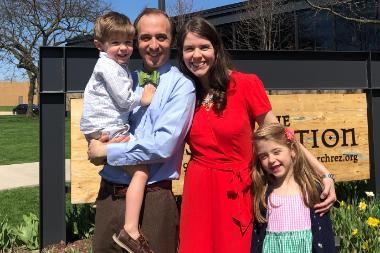April 24, 2020
Wheaton College English professor Dr. Richard Gibson on the occasional delights amidst the difficulties of the pandemic.
 Juggling work and family aren’t easy under ordinary circumstances, but a pandemic makes the effort particularly challenging. Wheaton College English professors Dr. Richard Gibson and Dr. Alison Caviness Gibson are not only teaching students across a total seven courses between them, they’re also homeschooling their three-year-old son and seven-year-old daughter for the first time. But even during this time of social distancing, Dr. Richard Gibson has found “unexpected joys and beauties.” He encourages his students to do the same.
Juggling work and family aren’t easy under ordinary circumstances, but a pandemic makes the effort particularly challenging. Wheaton College English professors Dr. Richard Gibson and Dr. Alison Caviness Gibson are not only teaching students across a total seven courses between them, they’re also homeschooling their three-year-old son and seven-year-old daughter for the first time. But even during this time of social distancing, Dr. Richard Gibson has found “unexpected joys and beauties.” He encourages his students to do the same.
How has the stay-at-home order changed your routines of home and work life?
Dr. Gibson: I'm accustomed to having at least part of every workday open for grading, writing, or e-mailing with students, colleagues, and peers at other institutions, even on teaching days. I've tried in recent years to block at least one day where I can work for at least six hours without interruption. This semester, that's been Fridays. After dropping one or both of the kids off at school in the morning, I would head to a coffee shop and work, work, work. Obviously, our new condition doesn't allow for that kind of freedom to choose what to work on and where to work on it.
We're dividing up the standard business day—8 to 5—into chunks in which we take turns watching the kids. So far, I've been working from whenever I wake up until 10, then heading out with the kids for exercise in the late morning. I make lunch and put our three-year-old down for a nap around 2 or 3. After that, I work until I prepare whatever meal (or when the kids are fussy, meals) we're having for dinner. The evening hours are family time until we divide and conquer for bedtime.
How are you making this disrupted schedule work?
Dr. Gibson: We've had some success with new mealtime rituals. Every morning at breakfast, Alison reads a poem. At lunch, I introduce them to a famous artist or movement. We started with the Dutch Golden Age, and the kids both loved Vermeer. We spent three lunches looking at Picasso's work. I've been pleased to discover in the process that lots of museum websites have tools designed to appeal to a child's perspective. I know a lot about the history of art, but I've been pulling in a lot of these visual materials to enrich the conversation.
In addition to teaching your own children, you’re also teaching Wheaton English students. With just a couple weeks left of the semester, how are you encouraging your students?
Dr. Gibson: In response to a survey that I sent out to my students to see how they are doing, several wrote things along the lines of "scared," "anxious," and "stressed." I want them to know that I'm feeling those things too. I would encourage them to strive to remain open to the moments in the day when unexpected joys and beauties intrude. We may delight in those moments. We may even give thanks for them. Suffering has a profound way of throwing the good things of the world into high relief.
Any other advice you’re offering students?
Dr. Gibson: I've heard from a few students who feel strongly that they ought to pray but, quite frankly, aren't sure how to do so under these circumstances. My advice is to go to the Psalms, which has been a resource for Christians in distress from the beginning. Here's a formula that they can adapt:
- Read a Psalm. If you don't know which one, ask the Church. Use a lectionary to find out which psalms some of your fellow Christians are reading each day.
- Ask the Psalm for words to speak for you. Use those words in your prayer. The beauty of the psalter is that its poets express our fears, doubts, anxieties, and frustrations, along with our joys, delights, and thanksgivings.
- Name those who are in need of prayer. If you have a specific petition to request on behalf of that person, make it. If you don't, don't worry about it; naming is a petition. I like to imagine myself reaching out to the beloved party at the moment of prayer.
- End the prayer by reflecting on how Jesus would pray the psalm, and then say His name and be done with it. Amen.
For more on teaching during COVID-19, read Dr. Gibson’s article “On Tele-teaching” in the Hedgehog Review.